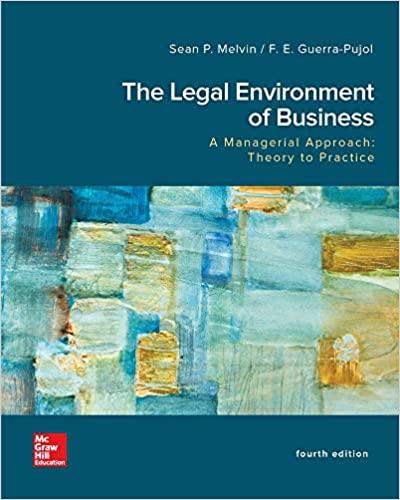Question
Please consider the following fact pattern and answer the questions below. On September 1, 2017, Mercury Corporation (Mercury) mailed a purchase order to Glass Manufacturing
Please consider the following fact pattern and answer the questions below.
On September 1, 2017, Mercury Corporation ("Mercury") mailed a purchase order to Glass Manufacturing ("GM") for precision glass tubing to be used in the manufacture of indoor and outdoor thermometers. Mercury ordered 5,000 1-foot lengths of glass tubing, at a price of $5.00 per foot. Mercury's purchase order also indicated that GM should deliver the glass tubing at GM's expense no later than October 1, 2017. After receiving Mercury's purchase order, GM mailed a written acknowledgment, agreeing to all of Mercury's terms. GM's acknowledgment also contained a disclaimer of all implied warranties and a provision that limited Mercury's remedies to replacement of any tubing that was broken or otherwise lost in transit. GM delivered the tubing and Mercury accepted it and paid for it. Later, Mercury determined that a significant portion of the shipment was of inferior quality and unfit for the use for which Mercury bought it. Assume that the inferior tubing would violate the warranty of merchantability (the product is not fit for its ordinary use).
- Explain why this is an enforceable contract despite GM's additional term. Your answer should discuss whether an acceptance must mirror the offer when the Uniform Commercial Code applies and how the Uniform Commercial Code handles additional terms in an acceptance between parties similar to Mercury and GM.
- Mercury sues GM for violation of the warranty of merchantability. GM argues that its additional term in the order acknowledgement (disclaimer of all warranties) should apply and there is no warranty. As an additional term, has this limitation of warranties become a part of the contract? In other words, is there an enforceable warranty?
- Would your answer change if Mercury's purchase order stated that "all warranties set forth in Article 2 of the Uniform Commercial Code apply to this transaction?" Please answer the question and explain how you reached this conclusion.
Step by Step Solution
There are 3 Steps involved in it
Step: 1

Get Instant Access to Expert-Tailored Solutions
See step-by-step solutions with expert insights and AI powered tools for academic success
Step: 2

Step: 3

Ace Your Homework with AI
Get the answers you need in no time with our AI-driven, step-by-step assistance
Get Started


